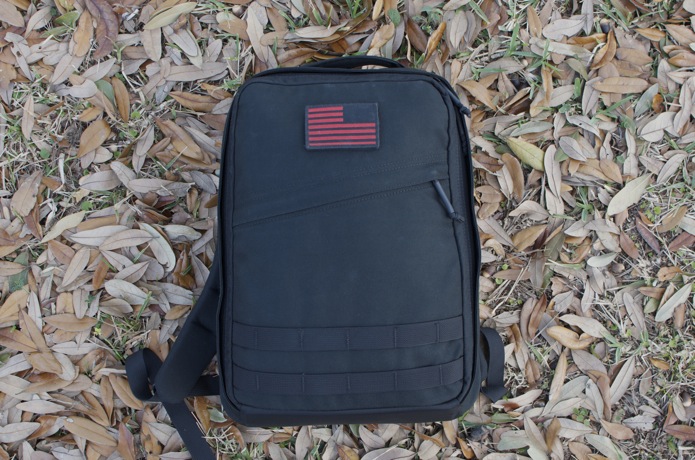
An ‘Echo’ of our other rucks, this smaller version is every bit as tough and every bit as functional. But its size gives it a different story to tell. Sort of.
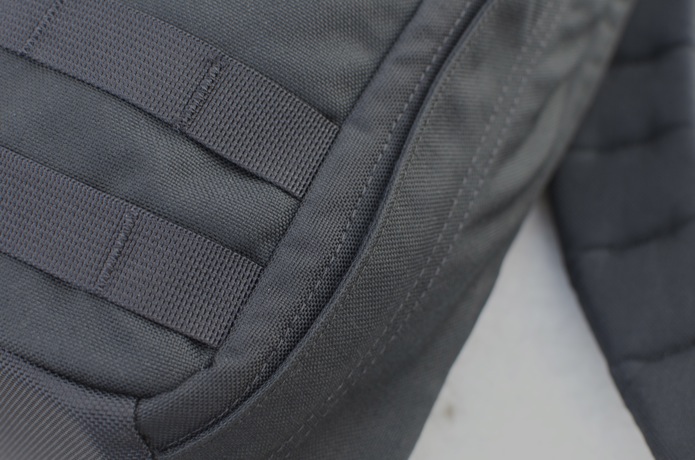
All our rucks have consistent features. The Echo has two rows of MOLLE webbing (the same system used by our Armed Forces to attach accessory pockets, carabiners, etc.) across the front. You’ll notice that the webbing is sewn directly into the seam between the front panel and the side panel (which contains the main compartment’s zipper). This technique allows us to sew the end of the webbing down on the inside of the ruck where the two panels come together.

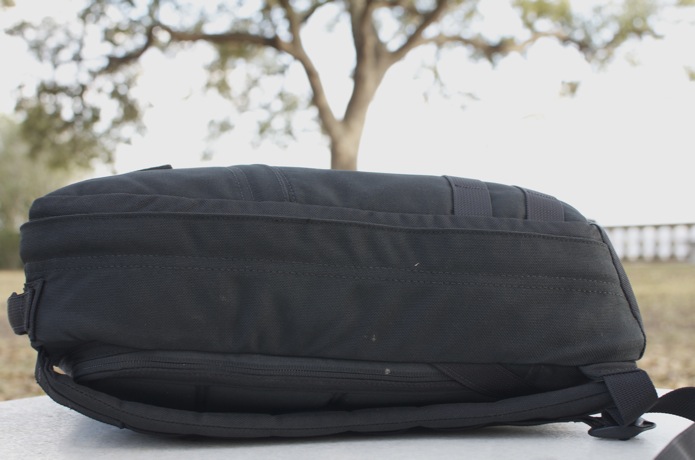
This technique would not be possible on the sides of the Echo. Pictured above, notice the two rows of stitching running horizontal and parallel through the middle of the side panel. The strip of 1000D Cordura above them is called a rain guard; behind the rain guard lies the zipper. We laugh about the term ‘rain guard’ a little bit at our factory because neither the zipper nor the ruck itself needs guarding from the rain, but since the industry calls it this, we opted not to call it a knife guard or something like that. The point of all this talk of seams and the rain guard is to say that there is no closed seam where we could sew webbing into — and even if there were (if the rain guard didn’t exist), limited real estate on the side panel would limit functionality. The Radio Ruck has externally bartacked webbing, meaning it is not sewn into a seam, but the Echo lacks the Radio Ruck’s real estate on the side panel, so the Echo doesn’t have any MOLLE webbing.
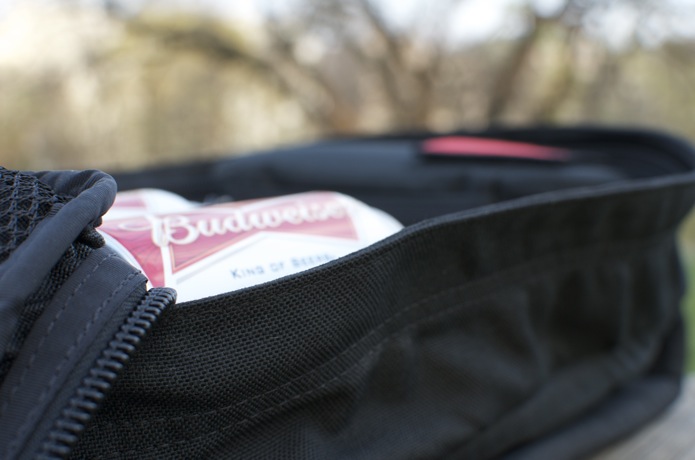
More detail of the rain guard (and a preview of a mostly empty ruck with the essentials I pack first). The zipper head (with the pull attached) is hidden behind it, along with half of the unzipped zipper chain. When zipped up, the full zipper chain is protected by the rain guard.

Pictured above is the front slant pocket zipper pull. The zipper head and chain are tucked behind a rain guard. Similar to the rain guard along the side panel, this strip of 1000D Cordura guards the zippers (always the weakest part of any ruck) from abrasion, dirt, mud etc. Our silent zipper pulls need less protection, though. They’re constructed from parachute 500 cord encased in a rubber tubing that allows for an easy grab even with reduced dexterity or when wearing gloves. And they don’t make any kind of annoying noise when you’re walking, or running, around.
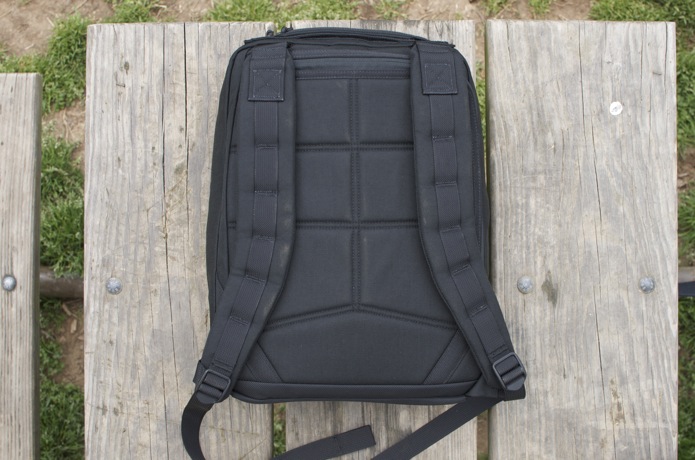
The Echo’s back panel and shoulder straps are identical in design to our other rucks, only smaller. The shoulder straps took us a few rounds of prototypes to size correctly. The Echo has less volume capacity than Radio Ruck so its shoulder straps are smaller because you need less padding to carry less weight. How much smaller was the question, though, and the only way to test it out is trial and error. So that’s what we did before they were ready to go.
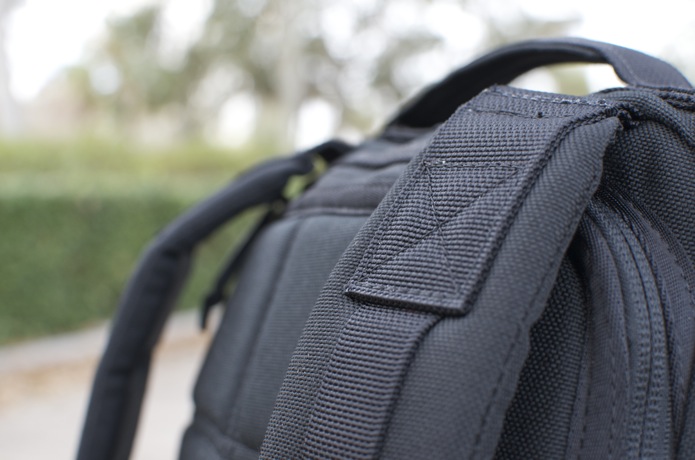
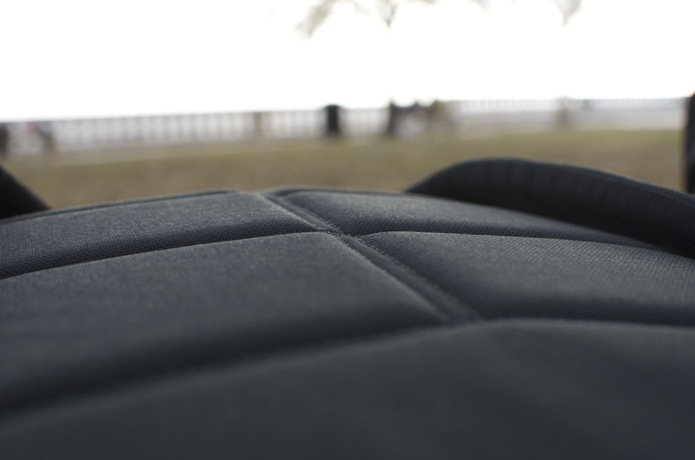
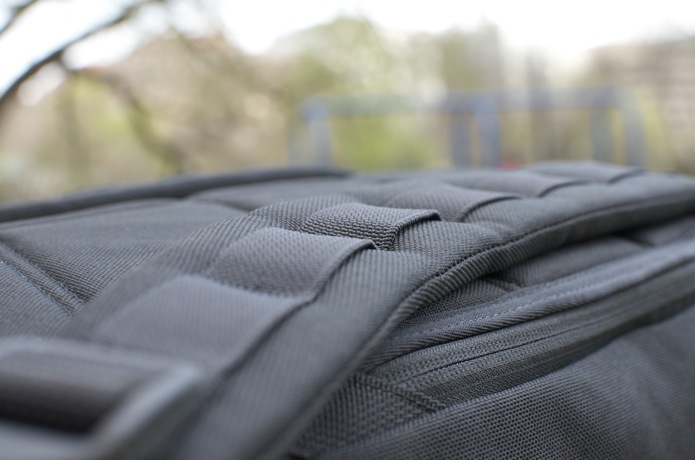
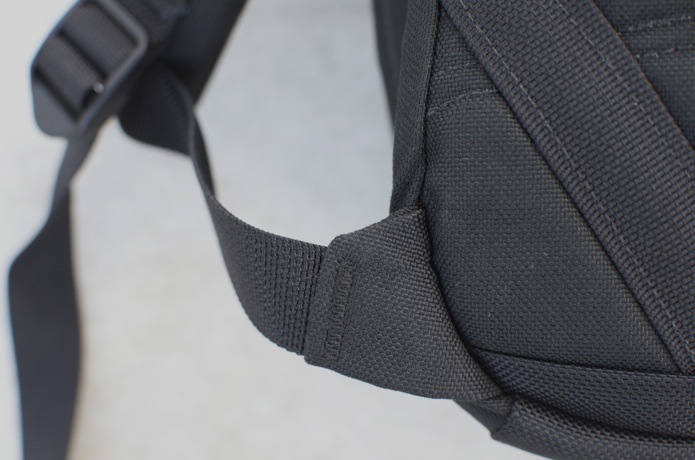
A small batwing coming out of the bottom base of the ruck where the back panel meets the side panel – and just above the bottom panel of ballistic Cordura. Notice the line of zig-zag stitching on the end of the batwing. This is a common though very heavy duty stitch called a bartack. And I love it. Its absolute strength is determined by the kind of thread used and the fabric used to bartack onto. It doesn’t make sense to use the bartack everywhere — it’s also unnecessary — but attachment points for shoulder straps are very high stress points on the ruck and so in this case it’s vital. The bartack on our materials is strength tested at over 400 lbs – enough for just about any kind of abuse.
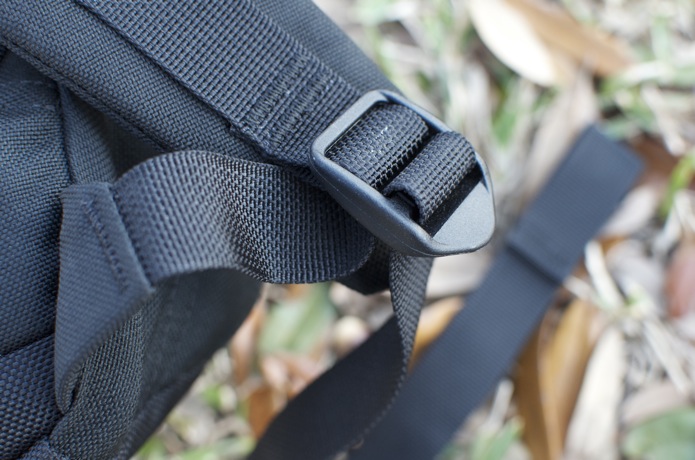
There are a lot of different buckles on the market. Some good, most bad. Our default is always to get samples of the best we can find and see how they function. Then we try to break the ones we like. When we can’t, and they function well with our other materials, that’s what we use. So, our buckles + our webbing — the friction that exists between the two matters for performance. More friction = less slip, but too much friction = too hard to adjust. We’ve put them through hell and they work well together and will be just fine. And we expect that you will, too.
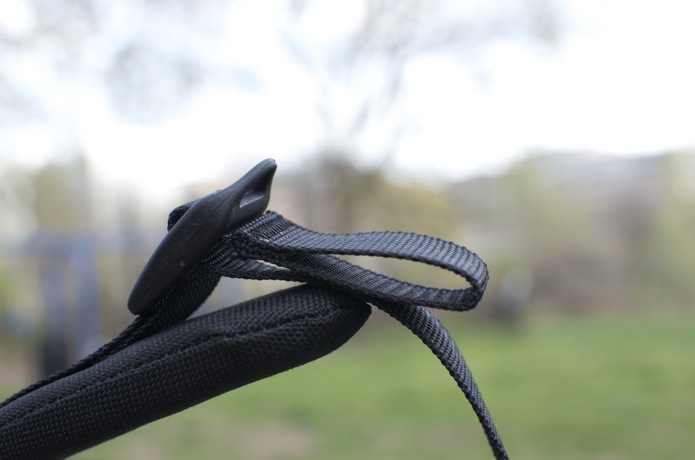
This little loop saves a lot of annoyance. The process of picking a stubby end of webbing out of a buckle sucks, so you’ll never have to do that with ours. You can grab this loop easily and cinch the ruck down on your back according to your preference. A small side note is that our rucks are meant to ride higher on the wearer’s back, which puts more of the content’s weight on your shoulders and back as opposed to your lower back and core. Less bouncing around is more stable, so if you’re moving around a lot, you’ll want to cinch the ruck down pretty tightly.
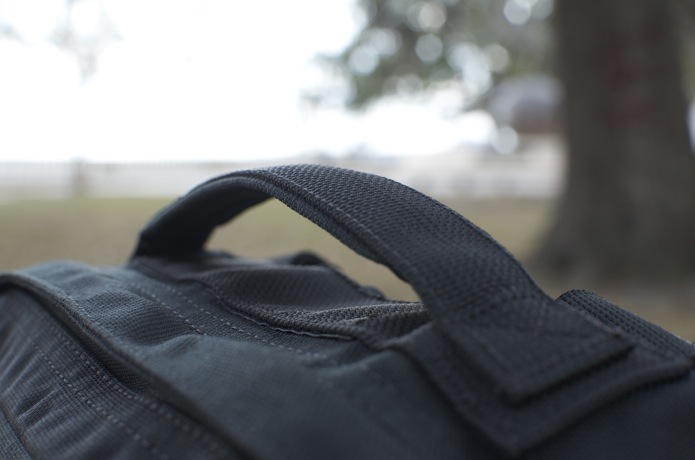
The carrying handle is padded and makes the ruck easier to deal with when you’re taking your Echo on and off. I used to travel with all my super heavy military gear, and this padding was never to be found on anything, so my hands took a beating. The bottom line is that our carrying handle serves its purpose better because there’s a little padding.
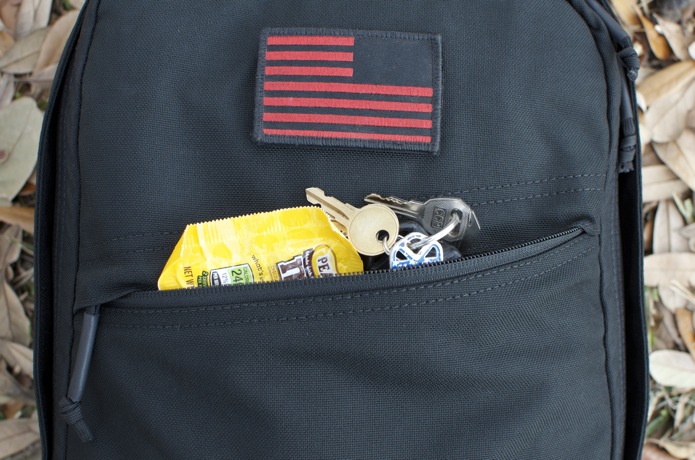
I put essentials in the front slant pocket. Like Peanut M&M’s and car keys. The slant pocket is always easy to get at.
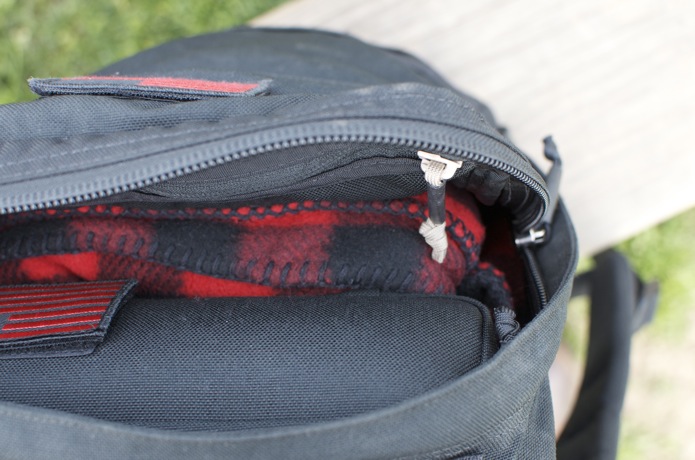
When you take the ruck off your back, you put it down (that’s usually my process, anyway). Pretty quickly you’ll get used to ‘working’ out of the top of our rucks. You can easily access the front slant pocket from above; you can also partially open the main compartment and then open the top internal pocket, which has a coyote colored zipper head and pull. What stuff you decide to put in which of these two pockets is up to you. Over time, our rucks become yours more and more, and you figure out how you like to set them up.
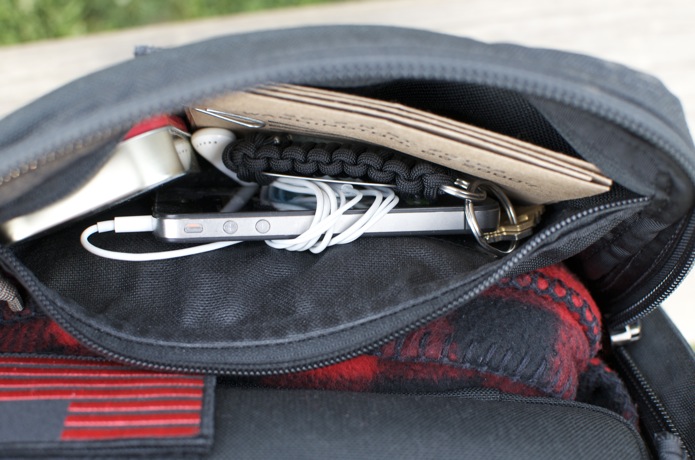
In the design of the top internal pocket, we never liked the idea of special sections for things like pencils or whatever else. I used to own those kinds of bags with all sorts of loud zippers and (not-so) special compartments everywhere, and I found myself never using them and wishing they weren’t there. So the Echo’s top internal pocket has no (not-so) special compartment. In our view, the whole pocket is special because you can do whatever you want with it.
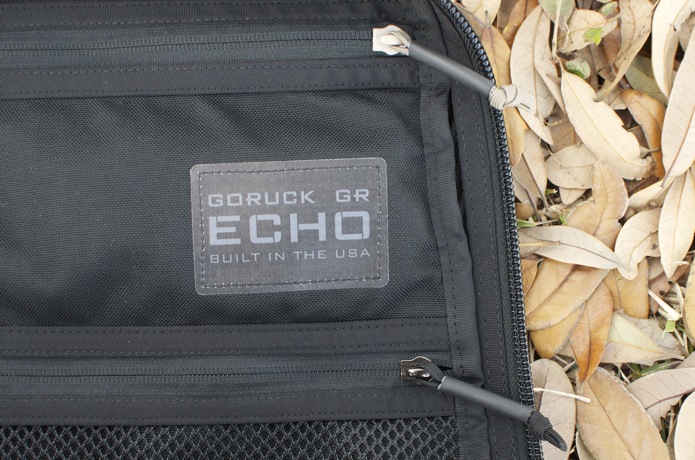
This is the only label on or in the ruck, and it’s sewn down to the top internal pocket. A little on the back story of how ‘Echo’ became “GR Echo”. In a word, lawyers. Before the ruck was complete (time machine back to 2009), we had to name it and get labels done up, etc. We didn’t have money to spare on legal counsel, but a friend of a friend knew a guy who agreed to chat with me for a few minutes about a few things. This was one of them — he said there were other brands that used the name Echo and that to avoid a lawsuit later on down the line, we should differentiate the name. So we did, even though we never called it anything but ‘the Echo’. And while it pays to know a guy for everything when you’re starting up, — it’s all part of the fun of starting a business and learning how to ask anyone for just about anything — sometimes you have to make decisions that last based on a guy’s 2 second investment of time. I don’t know if this naming differentiation matters, but this was one of those ‘better safe than sorry’ moments, so GR Echo it was. And still is, sort of.
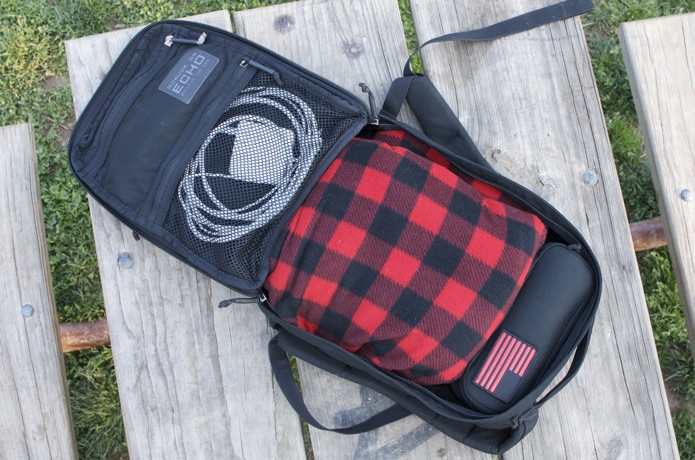
The Echo lies completely flat, a feature that makes it more fun to pack and allows you to be as precise as you want to be with weight distribution inside the ruck. Especially if you’re planning to have it on your back for a long time, you want the internal section to be as stable as possible. More stability makes for less shifting around of the contents and less noise. If everything’s moving around too much, the weight will shift from shoulder to shoulder and that’s not as comfortable. And if you have beers or something like that in the ruck, more stability aids in reducing their foam upon opening. I use RR Field pocket at the top and have a blanket stuffed in (Java’s makeshift bed when we’re at an outside bar or something) to help with stability, but this could also be a jacket or change of clothes.
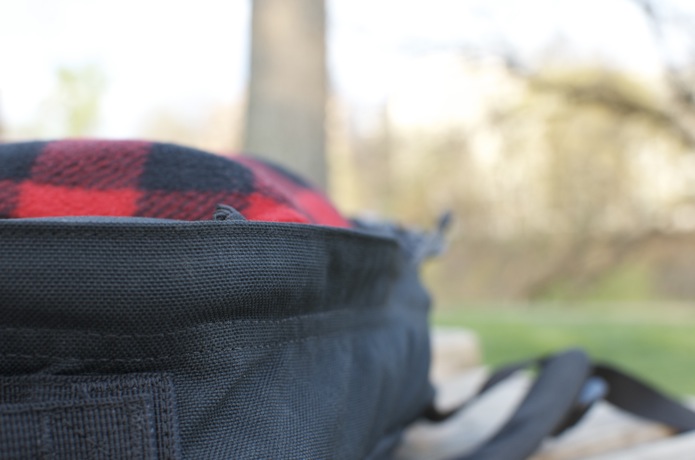
Lying flat. Also, this is another angle of the rain guard mentioned earlier. It’s the section above the horizontal parallel running double stitch.
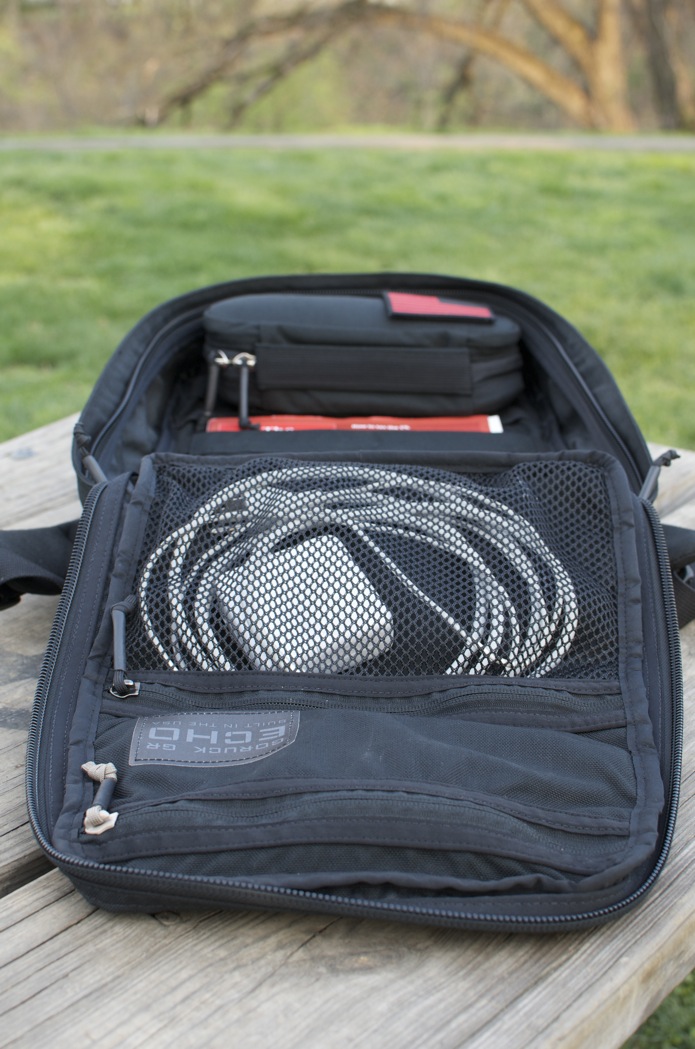
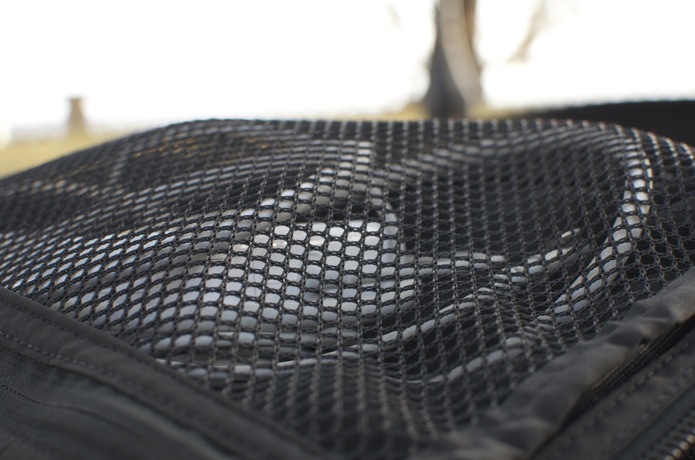
I always travel with a computer, which always has a power cord. This pocket made of military-grade mesh has become my go to for electronic wires, camera battery chargers – and other things like that that I want to be compartmentalized but also visible. If I have a bunch of wires in there, I don’t always want to grab all of them out at once.
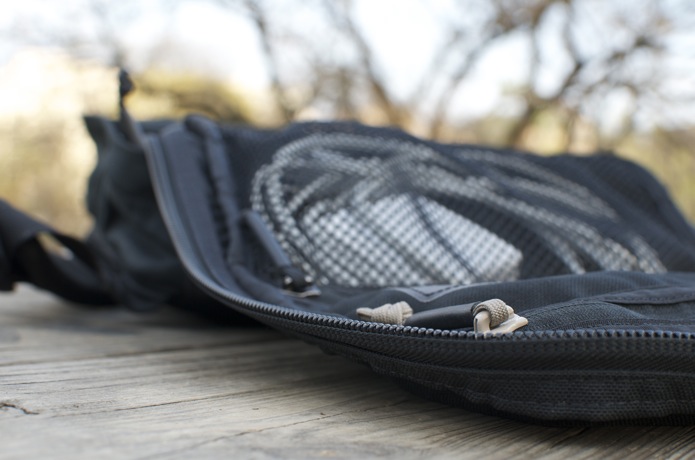
We get the question pretty often about why this zipper pull is coyote. It’s a small detail – consistently found in all our rucks – and very subtle. People are visual, and over time you’ll associate this zipper pull with this pocket — and eventually you’ll associate this pocket with the kinds of things you like to put in it, and how you like to use it. If you ever want to customize your own pulls, you could buy some 550 cord in any color you like and replace ours with yours. We hope you’ll make our gear your own; this is one pretty simple way to do that.
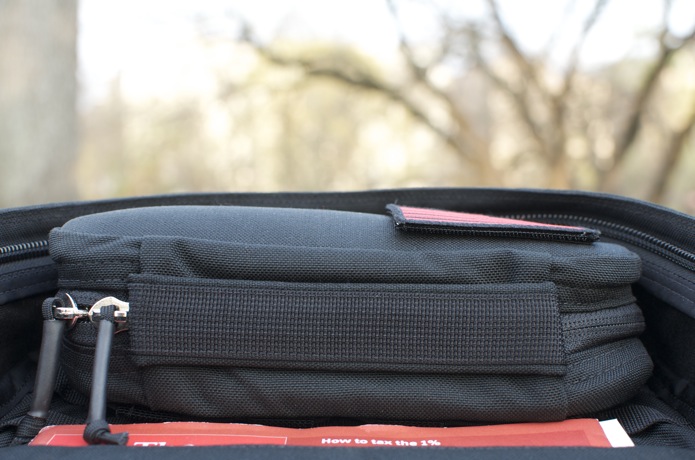
RR Field Pocket, which is sized perfectly to the MOLLE webbing at the top of Radio Ruck and the Echo. Check out Attaching Field Pockets Explained for that process. Having RR Field in the Echo gives you a little more internal compartmentalization, which can be especially helpful if you travel with a lot of electronics.
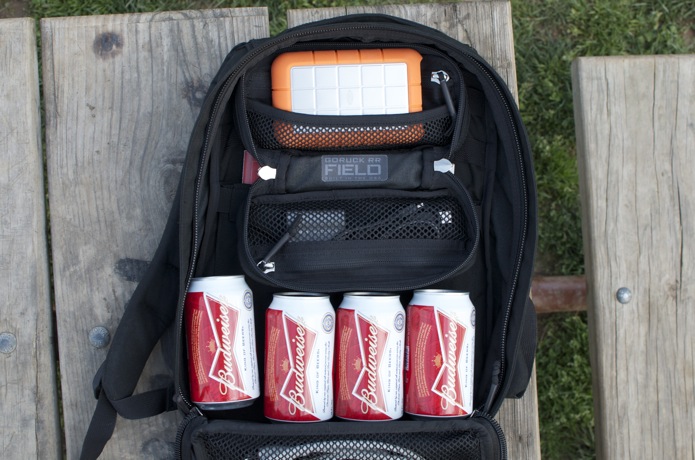
For instance, I prefer to segregate my external hard drive from beer or dirty clothes or whatever, and RR Field helps to that end. You never know when a perfectly good beer might explode inside your ruck.

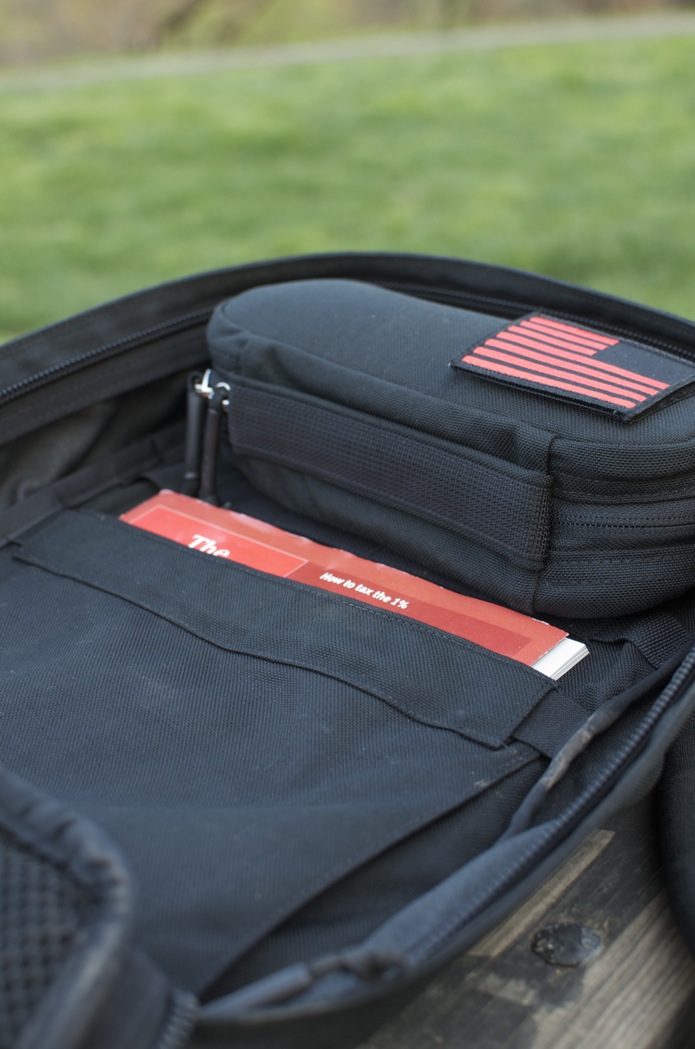
I use the internal sleeve for magazines or notepads, that kind of stuff. The top of it has an encased strip of elastic, which adds durability.

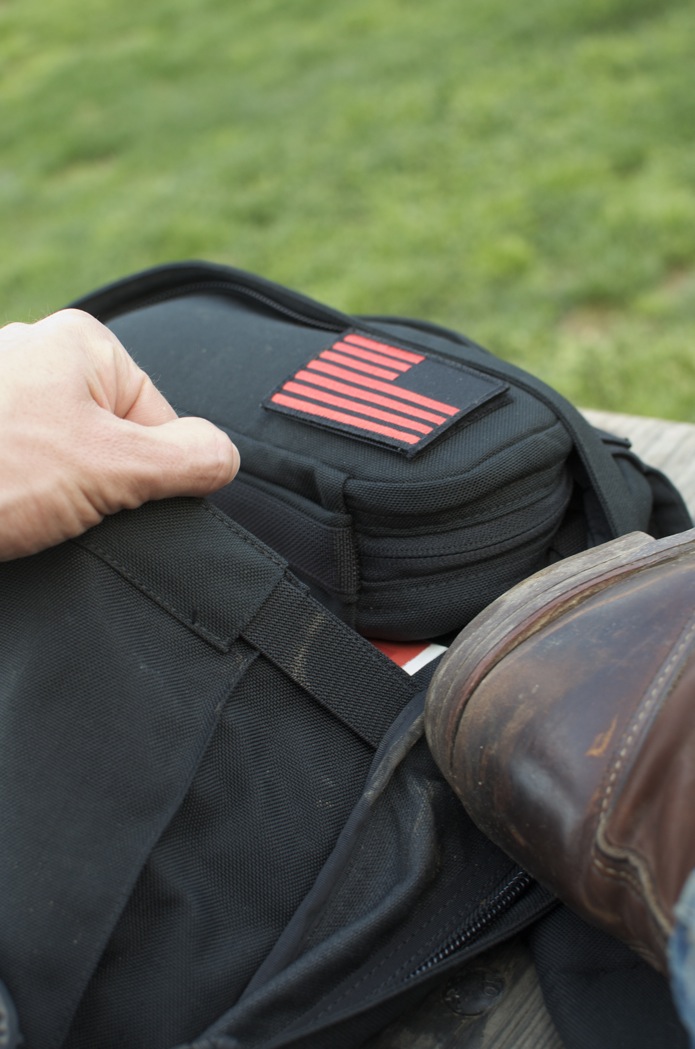
It opens up more than you might expect. This allows you to access contents more easily — especially if you have a RR Field attached inside the Echo. We also get the question about how this sleeve functions if you have the RR Field attached. Naturally, getting a magazine in and out of the sleeve is easier if you don’t have RR Field attached, but it’s no big deal to lift the sleeve up and move stuff in and out if you do. On a side note, a picture of me taking this picture would probably be worth a lot of laughs.
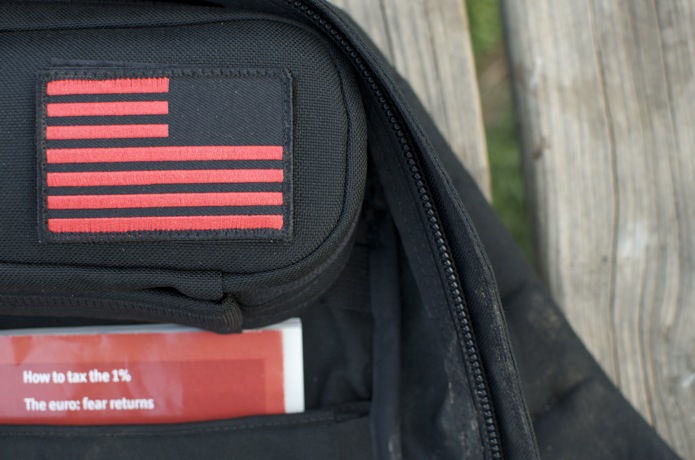
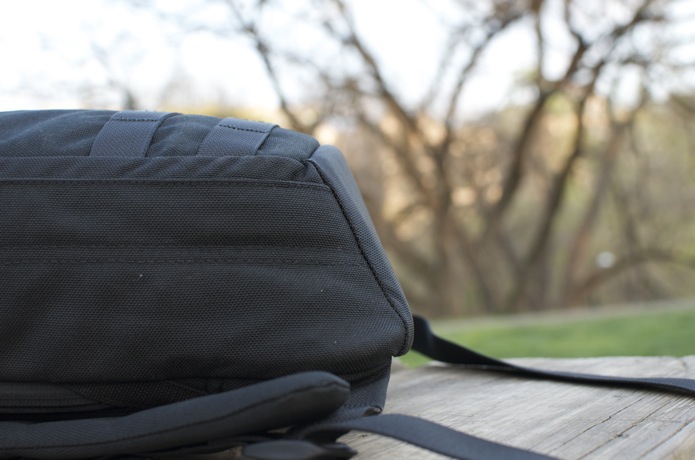
The slant at the bottom of the Echo is present, in varying degrees, on all our rucks. This is another subtle thing, and it comes with a tradeoff. Packing light in an organized fashion used to be a matter of life or death for me — at least we treated it as such back in my Special Forces days. I learned about what was comfortable, and why, based on how I packed it. A 4 day patrol with 100+ lbs on your back had these kinds of small, silver linings. One thing that I learned was that the closer any items of significant weight were to my back, the better. This very subtle slant has a way of pushing heavy things toward the wearer’s back — think about it in terms of my beer cans. My beers are weighing down the bottom of the ruck, but they’re more likely to stay closer to my back because of how they’re packed there, with a blanket on top to fill some space.
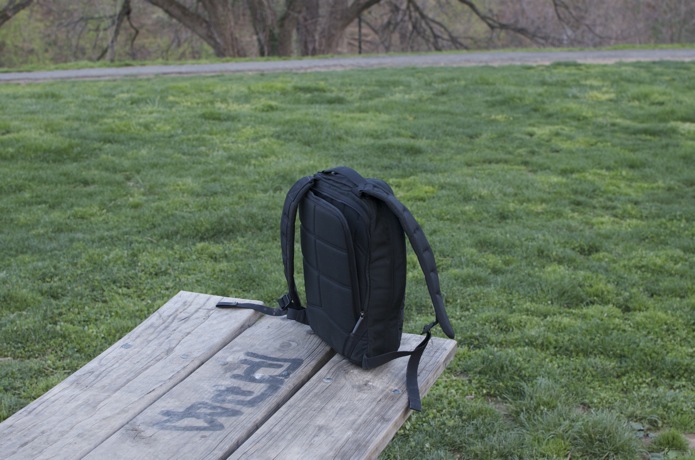
The other part of the tradeoff is that the Echo is less likely to stand up straight, on its own. In the picture above, though, my beers are weighing it down pretty well, and it’s fine on its own. But this is the exception, not the rule. Most of the time, the Echo won’t stand up straight on its own. In those instances, it’ll be better served on your back or lying down flat. Our other rucks have the same issue, but there’s more space at the bottom of the ruck. When weighted down, they rest standing up just fine.
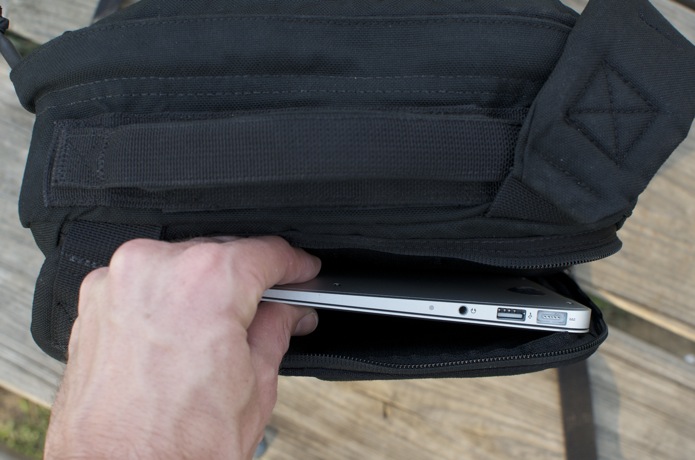
Earlier I mentioned that you’ll become used to working out of the top of the Echo. This includes the laptop compartment. The Echo comfortably houses an iPad and up to a 13″ MacBook Pro. Pictured above is me grabbing at my Macbook Air.
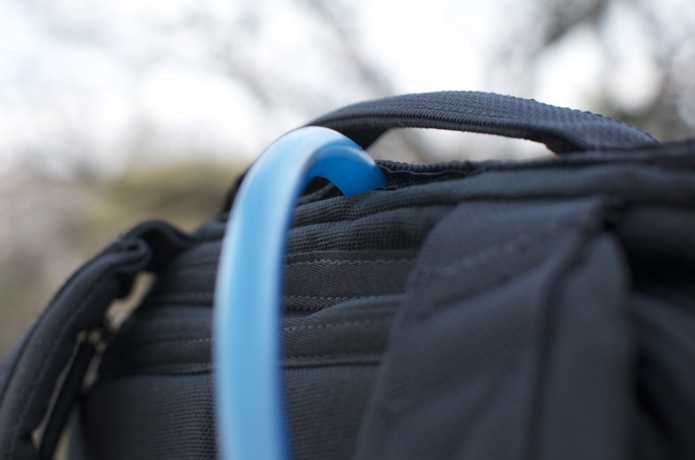
Based on what you’re doing, you can put a hydration bladder or a laptop in the compartment next to the wearer’s back. But preferably not both — laptops and water don’t play well together. And the bladder’s tube comes out of a Velcroed down section underneath the padded carrying handle.
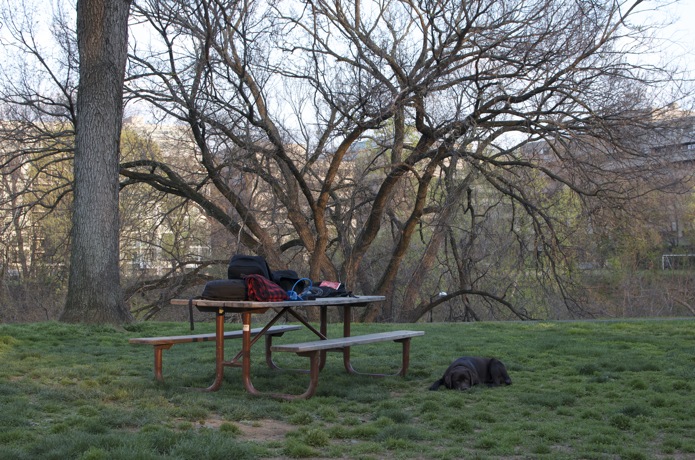
Behind the scenes. I find a spot I like and set up shop. For this one, Java was either chasing squirrels or faithfully by my side. (He has a well documented case of separation anxiety.) I took photos of the Echo over the course of three days (one day was in Jacksonville, FL, two at Rose Park in DC) and intended initially to do some relative sizing pics as well, meaning Echo vs Radio Ruck — hence all the different rucks on the picnic bench — but the way it played out, I want to save that for a separate post. Echo Explained, from start to finish, took a lot of time (~20 hours) with my camera and then in front of a computer, drinking beer, cursing this or that shot I forgot to take. So then I get my camera again, etc. And I don’t have a single complaint in the world. I feel blessed to get to do this stuff, and hope to meet as many of you all as possible face to face, which I always prefer to sharing photos.
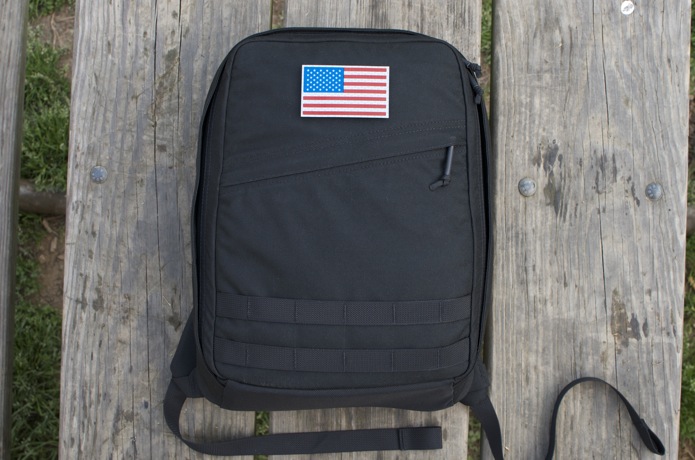
One of my old uniform flag patches was next to the door on my way out and I grabbed it just in case, cause options are a good thing. Gear is cool, better gear is even cooler, and our goal is to make the best. But we at GORUCK want to be so much more than just a gear company. It’s our aim to promote the causes we love and support: the US military, US manufacturing, and local pride — as well as just do right by people, who make everything better. People we meet face to face and people we hope to. My past has a way of consistently resurfacing and reminding me that there are no short-cuts, no second chances to do right the first time. And the flag I wore is the best symbol for me of that past and a desire to live up to it and the people who wear it for a living. So thanks for all the support, and I hope you continue to expect big things from us.
jason, the original GR Echo was the first piece of gear I ever bought from GORUCK and it still is my go-to ruck for everyday activities and for more specialized ones as well. The new version of the GR Echo is, to me, the perfect sized small ruck. Coupled with the RR Field pocket it allows for efficient packing and organization.
Thanks for posting the “Echo Explained”, i’ve been waiting for this one for some time.
Keep up the fantastic job GORUCK is doing and I can’t wait to see what the future bring.
The GR Echo also makes a manly baby bag! Quick and organized access to all baby “emergency” gear. It’s a great everyday ruck, especially if you carry a computer. I can simultaneously hold my iPad and 13″ MacBook Air in the padded compartment. And for off-hours, it’s comfortable to wear trail running. I’m looking forward to grabbing some Idaho peaks with it this summer. Thoughtful design and quality manufacturing is hard, and it’s clear you put in the work. Thanks for a great product.
Nice Economist magazine!
Thanks for these “Gear Explained” posts – very, very helpful. Does the new, larger Echo fit inside the GR2 (for instance to use as a daypack once you arrive at your destination)?
Thanks for checking them out, Kate. The Echo definitely fits inside a GR2 (all our other rucks, including GR1, fit inside a GR2). I highly recommend traveling with a GR2 and an Echo. When you get where you’re going, your GR2 has everything you need, but is a bit large to carry all day, every day, everywhere. It’s on my list to do another Explained post called ‘Traveling with a GR2 and an Echo.’ Till then, you’ll have to take my word for it.
I’ve been rolling with my Echo for about 2 months now. In that time I’ve made an international move from Japan to the USA. I used my Echo for my carry on and packed quite a lot of travel essentials in there, see my photos on facebook where I tagged GORUCK. I’ve found it is perfect for EDC and day hikes. I’ve taken it into the Joshua Tree National Park every weekend while I’m in 29 Palms packed with the standard day hike stuff. I use it every day as a “school bag” of sorts. It carries all my notebooks, pens/pencils/highlighters etc..classroom handouts/books and most importantly my 1 liter stainless steel water bottle and 24 oz stainless steel coffee thermos! Of course I stuff bricks and sand bags in there for extra resistance during physical training. In the future I see it serving as my EDC/bug out bag in the car, I’m planning on adding the GR1 to my gear list. Best part about the bag is two fold: 1) It meets the very stringent Marine Corps uniform standards. It’s a civy pack that can be worn while in uniform and not draw super lifer attention! 2) It is a conversation stimulator for potential future GRT members! I get asked about it almost daily out here on the Marine Base and encourage each of them to get in on the good livin! It also attracts other Ruckers like a moth to flame. Many a silent nod, grin and firm handshake have been shared while moving about my day. Arrugah!
Jason,
Great products, great site, great job with the business. Have you thought about introducing a ruck sized between the echo and radio? 20L capacity seems to be a popular size for other manufacturers. I’d also be interested in hearing more about what new products you have in the pipeline
Thanks, Ian. We get a lot of questions about different sizes. My best guess is that in the future (think: a couple years-ish) we’ll have a lot more offerings on the rucksack side. Our original Echo and original Radio Ruck were different sizes from what they currently are, and with some minor pattern adjustments we could bring them back and have 6 rucksacks. The larger issue is, though, that having two more means a lot more than just adjusting the patterns. We’re going to have colors, etc, in the not so distant future, which means that 2 more rucks is at least 6 more SKU’s — and while I really shy away from talking about cashflow and inventory costs (my focus is on how to make GORUCK one of the most respected brands in the world) — even a good company can go bankrupt in a hurry with a little bit of mismanagement on inventory. But the larger we get, the more options we want to give people — part of the brand building is also giving people what they want. Hope that makes sense, and thanks for the support.
Jason, is that an issue of The Economist in your Echo?
Indeed it is. In my former life I expected to spend a lifetime in something international affairs related, working for the US Government. I still love that magazine even though I’m pretty sure a weekly cover-to-cover read is impossible.
Jason,
I don’t know if there’s a need to bringing back old models (I’ve just sold my old RR and I’ve still got the old size Echo) given the similarities in size for some of them.
Rather I’d prefer the new echo (which I love and use every day) to be ever so slightly deeper, enough for a single channel of molle for flashlights etc. That said I’d be converted if you bring out a full zip original Echo. That’d be awesome.
You guys fucking rock! I travel about 150k – 200k miles a year, internationally and domestic. I always have a laptop, and sometimes my Nikon D800 and a hefty lens or two. But I also need to the flexibility to go on side trips. I have a dozen different messenger/backpack/camera/laptop bags and reconfigure each time based on my next trip, and still carry a collapsable backpack for those occasional side trips.
No more. This echo pack is all I will need! I love how compact it is, how travel bullet-proof it is, how it’s configured to carry at least one laptop, AND camera gear easily. And because it’s configured wide open, I can easily use it for those side trips too.
But your work is not done yet – when are you making a carry-on roller so I can simplify that too?
I love my gr1 & gr2 and waiting to my echo!
I believe that you can make more sizes colors but i will be happy to see more accessories
It will give us the option to customize the bag to our needs.
Keep the good work
Great set of bags you have.
Question: would a 15″ Macbook Pro fit inside the Echo main compartment?
I basically just want a backpack for my laptop, power cord, and wacom tablet.
The RR seems a hair bigger than I need.
Yes, it’ll fit inside the main compartment, there’s more space in there.
Any experience with the new, thinner 15″ MacBook Pro’s fitting in the laptop/hydro compartment?
Looking for the same info, Noel. Post here if you have it – will help with the choice between the radio and echo – the only thing holding my coworkers and I back from the echo is laptop accommodation, it seems.
I’ve had my Echo since December 2011 and I love it. I’ve ditched my old bail out gear bag, and now the Echo is my everyday bag. I take it to work with me every weekday (I’m an IT geek and sys admin) to carry my Toshiba Thrive tablet, a 10″ netbook, power cords, and my lunch.
One minor question….I don’t see the “batwing” on my Echo….was that a feature you’ve removed? And if so what difference has the removal made to the product’s performance/endurance?
Thanks, Markus. Batwings were actually a later addition. The assumption when we first designed the rucks was that they were unnecessary. And they are. My trusty GR1, the first, also doesn’t have them. However, when we started making a lot more — which means a lot of different sewers are making them — we saw some slight inconsistencies in the angle of departure of the webbing — the spot where the batwing is now. Bottom line is that adding it makes it more consistent. We’re talking down to the millimeter, though — yours is no doubt good to go.
Hi Jason. Trying to decide between the Echo and the Radio. I take the train to work daily and carry a new 15″ MacBook Pro, a book, a magazine, some papers, mail, a Blackberry (iPhone is in my pocket), that type of stuff. Not a messenger bag type of guy. I am 6′, 210. Would the Radio be overkill with a bunch of empty space? or, would the Echo look like a handbag on my shoulder? Any thoughts?
Mati – I’d say go with the RR. The Echo may look a little small on you. That said, if you don’t have much weight in it, you can sling the Echo over one shoulder and do it that way. (I’m 6’4″ and that’s the only way the Echo doesn’t feel like a really small handbag). Your call, man, and thanks.
Those bags look awesome! I’ve been looking for something like this for a while. So far my Dakine backpacks have only lasted one deployment each (on a ship no less) and I want something a bit more durable. The problem is that on a good day, I’m a whopping 5 foot nothing.
I’m stuck between the Echo and the Radio. Any suggestions? Also for future brick holding once I check the Challenge off my bucket list.
Thanks!
Makana – I’d go with the RR. The Echo is not an ideal Challenge ruck due to its (lack of) volume. The RR is a little boxier than the Echo or GR1 (which are longer proportionate to their volume if you know what I’m saying) and would certainly survive your deployment. Be safe man.
Would The echo hold four bricks?? I need a rucksack for the challenge
Good to go indeed, even without the batwing. It has survived two years of ownership, and GRC Class 433. I will be using it this Summer for a Heavy in DC. Thanks for your commitment to quality and consistency…even down to the last millimeter!
^^^Lisa, yes, the Echo does hold four bricks. I recently finished a Challenge with my Echo filled with four bricks (I weigh 130 lbs.) and a 3L Source bladder. Try to get creative with the MOLLE webbing on the inside of the ruck…I will say no more on the subject.
Hi,
Trying to decide on the Echo for laptop carry.
I realise the list spec is for a up to a 13″ macbook pro, but just wondering if the new ultra slim 15″ macbook pro would fit in the laptop compartment?
hie..just want to share my experience with my GR Echo.
i feels not comfortable carrying my 13 inc laptop as the back feels very hard.
is it because of the non frame sheet for GR Echo?
and the laptop compartment zip always ‘touching’ my right back shoulder.
so hope Goruck can improve gr echo.
🙂
Hi, I am planning to get either the Echo or GR1 (21l) for EDC.
Can the Echo fit water bottle diameter of 4.5 inches (Klean Kanteen 64oz)?
Thanks for writing this! Am contemplating between the Echo, GR1 21L and GR1 26L! Planning to use it for both EDC and GR events. Am at 177cm/5ft 10in.
Kinda like the fact that Echo “forces” me to pack smart and light. But am concerned about the lack of space for equipment should I find myself attending a GR Light, Tough, Heavy, or even Selection in the future.
Any comments?